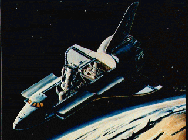|
|
BBXRT Software

The analysis of the data products
and the raw data in FITS format can be performed using the
XANADU and
FTOOLS suite
of programs.
Public domain software can be used to view the
GIF files (e.g. xv on UNIX or directly the
Netscape browser on any system PC and MAC).
 General Fits file manipulation :
The FTOOLS package,
futils , provides a
suite of programs that
can be used to view and manipulate any of the BBXRT archive files.
To view the data particularly useful are the tasks
fplot (to plot the data),
fdump (to dump the data file content), fstruct and
flcol (to get the structure and column name of the FITS files).
Basic selection and column manipulation can be done using
fselect (to select rows based on the result of a boolean expression),
fcalc (to calculate values for new column
based on arithmetic expression) and fstatistic
(to compute standard statistical value on a column).
Alternatively most of the operations (and more) mention above can be
done using fv , the
interactive FITS file viewer and editor.
General Fits file manipulation :
The FTOOLS package,
futils , provides a
suite of programs that
can be used to view and manipulate any of the BBXRT archive files.
To view the data particularly useful are the tasks
fplot (to plot the data),
fdump (to dump the data file content), fstruct and
flcol (to get the structure and column name of the FITS files).
Basic selection and column manipulation can be done using
fselect (to select rows based on the result of a boolean expression),
fcalc (to calculate values for new column
based on arithmetic expression) and fstatistic
(to compute standard statistical value on a column).
Alternatively most of the operations (and more) mention above can be
done using fv , the
interactive FITS file viewer and editor.
 Spectra and Lightcurves :
Spectra and lightcurves can be analyzed using
Xspec and
Xronos respectively.
Xspec is a general spectral fitting programs, providing a number of already
made standard models. To use XSPEC with the BBXRT archive files,
it is necessary to extract from the archive a source and background
spectrum and a response matrix.
Spectra and Lightcurves :
Spectra and lightcurves can be analyzed using
Xspec and
Xronos respectively.
Xspec is a general spectral fitting programs, providing a number of already
made standard models. To use XSPEC with the BBXRT archive files,
it is necessary to extract from the archive a source and background
spectrum and a response matrix.
The BBXRT lightcurves can be used in any of the Xronos programs, each
dedicated to a specific timing task.
 Raw files :
The average spectra and lightcurves are adequate products for many
type of studies.
However for specific study (for example spectral variation with
source intensity) spectra (and/or lightcurves) need to be re-extracted
from the raw data file, the events file.
The basic program to use is
Xselect . This extracts spectra
and lightcurves setting basic filtering on time, phase intensity, energy
and region.
Raw files :
The average spectra and lightcurves are adequate products for many
type of studies.
However for specific study (for example spectral variation with
source intensity) spectra (and/or lightcurves) need to be re-extracted
from the raw data file, the events file.
The basic program to use is
Xselect . This extracts spectra
and lightcurves setting basic filtering on time, phase intensity, energy
and region.
Before entering Xselect data cleaning and detector (pixels) selection
can be done using fselect .
Basic cleaning is obtained using the following expression
VLE==0 && GUARD==0 && LED==0 && PTP==0 && PPU==0
where VLE, GUARD, LED, PTP, PPU are columns in the BBXRT event file.
Pixel or detector selection is done instead using the column DETECTOR,
where the A detector is identified by the value 1-5 (1=A0,2=A1,..,5=A4) and
the B by 6-10 (6=B0,.., 10=B).
Example: create a clean event file for the pixel A0:
fselect
Name of FITS file and [ext#][] cygx1i.evt
Name of output FITS file[] clean.evt
Selection Expression[] LED == 0 && GUARD == 0 && VLE == 0 && PTP == 0 && PPU == 0
&& detector == 1
The output file, containing only good data, can be input in Xselect
 BBXRT Analysis issues :
The Legacy article on BBXRT
describes a number of calibration and analysis issues related with the BBXRT
data. In particular the following topics are discussed:
BBXRT Analysis issues :
The Legacy article on BBXRT
describes a number of calibration and analysis issues related with the BBXRT
data. In particular the following topics are discussed:
The instrument calibration is discussed in the
Weaver, K.A. et al , ApJS, 1995, 96 30.
[BBXRT Home]
[About BBXRT]
[Archive]
[Software]
[Gallery]
[Publications]
Page authors: Lorella Angelini Jesse Allen
HEASARC Home |
Observatories |
Archive |
Calibration |
Software |
Tools |
Students/Teachers/Public
Last modified: Monday, 20-Apr-2020 15:46:18 EDT
|


